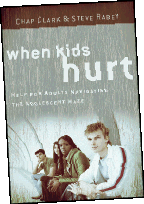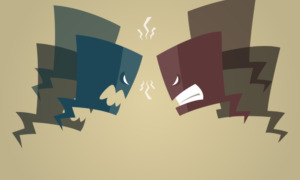 |
Chap Clark, Steve Rabey
Baker Books
208 pages. $13.99 paperback.
Adolescence, according to Chap Clark, senior editor of YouthWorker Journal and professor at Fuller Theological Seminary in Pasadena, Calif., “is fundamentally different than it was 30 years ago.”
During his sabbatical as a substitute teacher conducting participant-observation research at Crescenta Valley High School in northern Los Angeles County, Clark discovered how little adults know of teenagers’ inner realities. His students admitted that “loneliness is a central experience” in their lives.
Family structures shaped by divorce and other instabilities have left children to take care of themselves. Teens feel a “profound sense of abandonment.” One study shows that teens spend only 4.8 percent of their time with parents and 2 percent with other adults.
Students’ revelations, along with those from juniors and seniors in 10 American and two Canadian focus groups and a literature survey of teen culture and development, informed Clark’s scholarly 2004 book, Hurt: Inside the World of Today’s Teenagers. Sales of nearly 50,000 copies revealed adults’ hunger for insight into the world of teens. Clark was inundated with questions: Were those real kids? What can we do?
Fellow journal editor Steve Rabey helped reframe Hurt’s data for this new book to help adults address teens’ disconnection. Boxed “Youth Culture Updates” report on current conditions, such as youths’ high stress levels and use of drugs and alcohol. Sidebars contain 23 essays by youth ministers and church youth workers who responded to Hurt’s challenges; religious approaches are thereby separated from the main text, which maintains a secular focus.
Effects of adult abandonment of youth are entrenched and alarming. Without adults helping the developmental process along, adolescence lasts up to fifteen years. Adulthood no longer begins at 21. High school students used to be considered late adolescents, mature enough to make decisions about their futures. Now teens in grades 9 through 12 are considered “midadolescents,” a recently defined stage of development, Clark says. With adulthood as far off as age 25, midadolescents have difficulty visualizing the future. In his interactions with them, Clark noticed lags in abstract thinking. Although capable of insightful discussion, students couldn’t apply conclusions to real situations.
To form their own identities, teenagers have always challenged adult values. But today’s adults have fewer standards to confront. In reaction, teens have constructed what Clark calls a “world beneath,” a complex social system with its own moral code, more structured than any previous teen subculture. This safe place to survive harrowing adolescence is kept secret from adults; most are unaware of its existence. To Clark, “even the most ‘solid’ students confessed that life is far darker, far more violent, far more difficult, and far more tiring than adults, including their parents, realize.”
Adept at switching roles and personas between worlds, teens make adults believe that the selves they project are the whole package. “We are only seeing the tip of the iceberg,” says Clark. “The way midadolescents have been forced to design their own … separate social system has created perhaps the most serious and yet understudied social crisis of our time.”
By allowing “a small group of teachers to belittle, authorities to ridicule, coaches to discourage, and parents to neglect and abuse,” says Clark, “you and I have caused this distance.” We have “forgotten how to be together” in unstructured activities. Teams, clubs and lessons fill young lives. Individual nurture is out; competition and self-promotion are in. Clinging to their friends, teenagers wonder if anyone cares.
Trusting adults with the intimate reality of their lives is high-risk for teens; adults who do care must be careful in their efforts to penetrate. Some students allowed Clark the privilege of sitting “on the steps of their secret world,” where he saw both light and dark – cruelty, vulgarity and selfishness.
When Kids Hurt reveals teens’ lives in chapters on friendship, school, family, sports, sexuality, stress, ethics and morality, and partying. Those who haven’t noticed that cliques have morphed into clusters must not miss the friendship chapter, which reveals clusters as teens’ predominant safety net – groups of four to 10 like-minded peers, close in age and usually the same gender. In exchange for security and belonging, commitment to group values and accepted behaviors are expected. Particular clusters often last through high school and beyond. Of course, only sociologists and other adults call them clusters – kids are just hanging out with their friends. Teen society has become so oriented toward clusters that youth leaders find that small groups work better than large ones.
Clark’s revelations in other chapters might come as a shock, from sexual behavior to wild partying to teen ethics and morality; teens justify habitual lying to adults as self-protection, and cheating in school has become the norm.
Clark concludes by proposing 10 things adults can do to make a difference in young people’s lives, from becoming a caring adult for one teen to providing youth with boundaries or helping parents grasp three key concepts in understanding their children: the reality of lengthened adolescence, the phenomenon of teens’ underground living, and their perception that they’re on their own to figure out how to live. These suggestions alone justify the book’s value.
Clark doesn’t speak alone. In her essay, youth minister Kelly Soifer reveals that volunteer youth workers are especially valued by kids who “desire unconditional relationships with adults,” because these adults have chosen them. Such insightful essays show that churches are reaching teenagers with imaginative strategies that can be adapted for secular youth work or shared in collaboration.
Each reader will experience this compelling, unsettling book in his or her own way. Adults who care about teenagers might find these revelations a treasure trove, a Pandora’s box, scare tactics or old news. Some might challenge Clark’s conclusions. Others might commit themselves to helping make teens’ lives more rewarding. Whether inspired or provoked, many will welcome such frank discussion. Adults involved with youth in any capacity will want to examine Clark’s message. (800) 877-2665, http://www.bakerpublishinggroup.com.






























